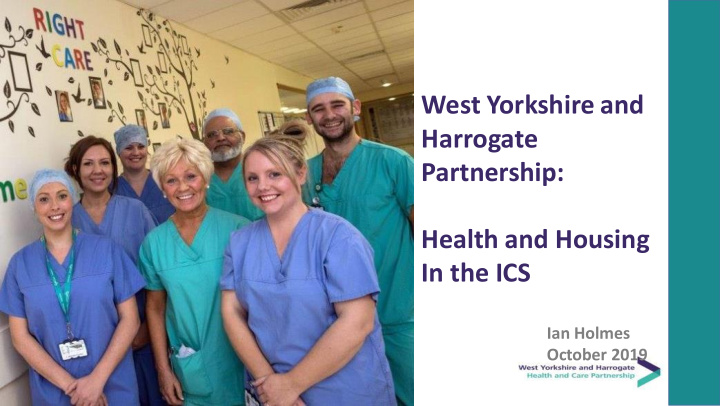



West Yorkshire and Harrogate Partnership: Health and Housing In the ICS Ian Holmes October 2019
We are one of the biggest health and care partnerships 2
The work we are doing to realise our vision 3
What might be different as an Integrated Care System National Policy Drivers (2012 Act) WY&H partnership • • Primacy of the organisation Focus on people and place • • Mixed priorities and regulatory Aligned shared ambition between requirements partners • • Emphasis on competition to drive Emphasis on collaboration to drive improvement improvement • • Financial mechanisms skewed Greater financial control to invest towards acute care upstream • • Performance focus on access targets Greater prioritisation of wellbeing and outcomes
We are making a difference 5
Our partnership has evolved over three years PHASE 5: PHASE 1: PHASE 2: PHASE 3: PHASE 4: Developing our Mobilising and Consolidating, Strengthening ICS development Five Year Strategy producing draft building governance and programme and embedding proposals capacity, and partnerships, new ways of working infrastructure building trust (May 16 - Dec 16) (May 19 onwards) (Apr 18 - Apr 19) (Jan 17 - Sep 17) (Oct 17 to Apr 18) We are now moving into the next phase, with greater accountability and transparency 6
What makes this so challenging? Accountability and compliance: A range of different systems exist: NHS organisations looking ‘upwards’ to national bodies, local authorities are much more locally and democratically accountable. Planning processes: Timing and requirements misaligned. Funding: There is a symbiotic relationship between NHS and wider funding but system is very fragmented. Relationships and Culture: Lack of understanding of drivers, motivations and ways of working. But we are all key influencers…….
Building trust through delivery and good governance… • Knowledge distribution - Wakefield District model of integration health and housing across the WY&H footprint. • Implemented ‘place to place’ peer review across the 6 places in WY&H. Learning from local government model of sector led improvement making it core WY&H approach to mutual accountability. • Invested £1m of NHSE transformation funding to support VCS organisations to tackle loneliness . • Our Partnership MoU was lengthy and occasionally painful process defining our governance and way of working. Rooted in subsidiarity, distributed leadership and democratic accountability. All local authorities and NHS bodies signed up as equal partners. • Our Partnership Board will meet quarterly in town halls across WY&H, chaired by a Council Leader.
With a good dose of ‘parity of esteem’ across the system We have a set of guiding principles that shape everything we do as we build trust and delivery Principles • We will be ambitious for the populations we serve and the staff we employ. • The partnership belongs to commissioners, providers, local government, NHS and communities. • We will do the work once – duplication of systems, processes and work should be avoided as wasteful and potential source of conflict. • We will undertake shared analysis of problems and issues as the basis of taking action. • We will apply subsidiarity principles in all that we do – with work taking place at the appropriate level and as near to local as possible.
Wakefield Health and Housing Partnership Sarah Roxby
WDH • Vision to create confident communities. • Stock transfer 2005. • Own and manage 45,000 properties. • Employ 1,400 people. • Community Benefit Society.
Wakefield Health
Governance Wakefield Place Governance Arrangements Wakefield CCG Wakefield Council Health and Wellbeing Board Connecting Care Executive Joint Commissioning Integrated Care Children and Young Panel for Children and Partnership People Partnership Board Young People Health and Housing Sub Group
Connecting Care Hubs “Creating person centred co - ordinated care.”
Our Wellbeing Offer
Vanguard: Tackling social isolation
Care Link hospital to home
Wellbeing and Mental Health Support
Housing support and coordination
Wellbeing support Get the App We are making it easier to access: • mental health / wellbeing caseworkers; • occupational therapists / adaptations; • independent living / extra care; and • Care Link
ILM 5 Qualification for Practice Managers • Delivered to 19 Practice and Office Managers over two cohorts. • Develops skills and knowledge to manage and lead within a GP setting. • Gain a recognised professional qualification to underpin learning.
ARMED
Primary Care Home
Key factors • Relationships, relationships, relationships. • Understand the ways of working, key decision makers and ‘influencers’ in each place. • Build consensus by identifying the win / wins. • Deliver some of the easier stuff first to build trust and confidence.
Proposed Future Model - West Yorkshire and Harrogate Priorities Priority areas for improving System change and integration Improving Population Health outcomes • Primary and Community • Prevention • Cancer Care • Mental Health, • Urgent and Emergency • Health inequalities Learning Disabilities Care and Autism • Improving planned care • Wider determinants of • Children and young and reducing variation health and wellbeing people • Hospitals working • Carers together • Personalised Care • Maternity Enablers • • • Harnessing the power of Capital and estates Finance • • communities Leadership and OD Innovation and • • • • Personalised Care Workforce Population health management Prevention Improvement • • Digital capability. Commissioning • • Wider Determinants Health Inequalities 25
Qu Questi tions
Recommend
More recommend